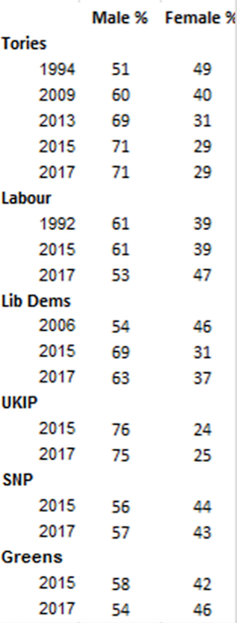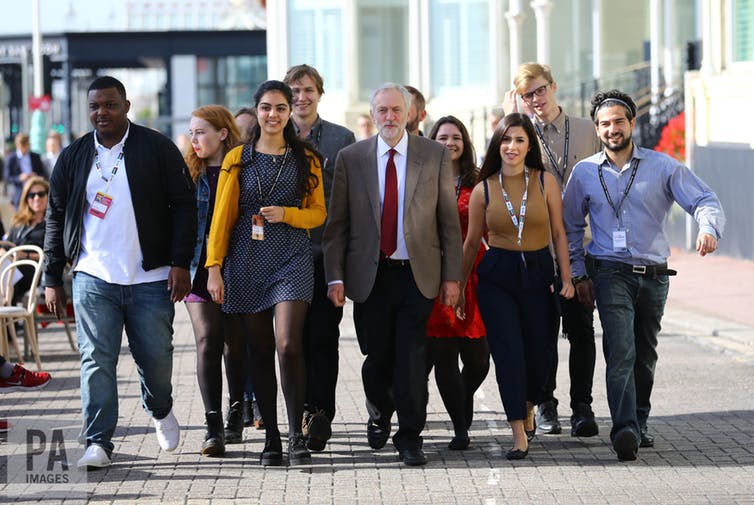Where have all the women gone? The Tories have a serious gender problem
Tim Bale,
Monica
Poletti, Paul Webb,
The Conversation, March 15, 2018
Monica
Poletti, Paul Webb,
The Conversation, March 15, 2018
The
latest findings on the gender imbalance among the rank and file memberships of
Britain’s biggest political parties make for worrying reading – particularly
for the Conservatives.
latest findings on the gender imbalance among the rank and file memberships of
Britain’s biggest political parties make for worrying reading – particularly
for the Conservatives.

Over-time
comparison suggests that there are now fewer women belonging to the
Conservative party than there were nearly a quarter of a century ago. The
Tories have, in recent years, increased the number of women representing them
in the House of Commons to 21% – an achievement that owes something to David
Cameron’s modernisation project and to the sterling work of Ann Jenkin’s Women to Win campaign, but
perhaps even more to the unexpectedly strong result that the party chalked up
at the 2015 general election. However, no such progress is being made in the
grassroots.
comparison suggests that there are now fewer women belonging to the
Conservative party than there were nearly a quarter of a century ago. The
Tories have, in recent years, increased the number of women representing them
in the House of Commons to 21% – an achievement that owes something to David
Cameron’s modernisation project and to the sterling work of Ann Jenkin’s Women to Win campaign, but
perhaps even more to the unexpectedly strong result that the party chalked up
at the 2015 general election. However, no such progress is being made in the
grassroots.
The
findings come from the latest surveys by the ESRC-funded Party Members Project
(PMP) run from Queen Mary
University of London and Sussex
University, carried out just after the last general election in June
2017.
findings come from the latest surveys by the ESRC-funded Party Members Project
(PMP) run from Queen Mary
University of London and Sussex
University, carried out just after the last general election in June
2017.
The lack
of women among the Tory rank and file could well turn out to be a serious
problem for those interested in getting the party to look more like the country
it wants to govern. As the recently-published comparative
study by the Swedish political scientist, Drude Dahlerup, makes
clear, anyone who is truly serious about getting more women elected to
parliament is going to have to consider the introduction of quotas. But they
will also need to pay attention to the pool and pipeline of potential
candidates available to political parties since, if there aren’t enough women
at the grassroots, then achieving anything like equality of representation will
prove an uphill struggle.
of women among the Tory rank and file could well turn out to be a serious
problem for those interested in getting the party to look more like the country
it wants to govern. As the recently-published comparative
study by the Swedish political scientist, Drude Dahlerup, makes
clear, anyone who is truly serious about getting more women elected to
parliament is going to have to consider the introduction of quotas. But they
will also need to pay attention to the pool and pipeline of potential
candidates available to political parties since, if there aren’t enough women
at the grassroots, then achieving anything like equality of representation will
prove an uphill struggle.
 |
|
What
happened to Tory women? Party Members Project, Author provided |
Overall,
far more men than women join Britain’s political parties, although the 61:39
ratio our 2017 surveys reveal means that the UK isn’t that unusual (or even
that terrible) in comparative terms. Data suggests the gender
imbalance in Germany is considerably worse and only a little bit better in the
famously more egalitarian Nordic countries. And, in large part because more
women than men have joined the British Labour Party in the last two-and-half
years, things are more equal in the UK than they used to be. But, sadly, that’s
far from true for the Tories. Right now, fewer than one in three grassroots
Conservative members is a woman.
far more men than women join Britain’s political parties, although the 61:39
ratio our 2017 surveys reveal means that the UK isn’t that unusual (or even
that terrible) in comparative terms. Data suggests the gender
imbalance in Germany is considerably worse and only a little bit better in the
famously more egalitarian Nordic countries. And, in large part because more
women than men have joined the British Labour Party in the last two-and-half
years, things are more equal in the UK than they used to be. But, sadly, that’s
far from true for the Tories. Right now, fewer than one in three grassroots
Conservative members is a woman.
 |
| Aggiungi didascalia |
The
situation might not be so worrying if the Tories could somehow tell themselves
(and the rest of us) that the direction of travel was positive.
situation might not be so worrying if the Tories could somehow tell themselves
(and the rest of us) that the direction of travel was positive.
But all
the surveys ever done on Britain’s three biggest parties clearly show that it’s
anything but.
the surveys ever done on Britain’s three biggest parties clearly show that it’s
anything but.
In marked
contrast to Theresa May’s, Jeremy Corbyn’s grassroots membership is (like the
Greens’) not that far off achieving gender balance. The SNP doesn’t do too
badly either, relatively speaking at least.
contrast to Theresa May’s, Jeremy Corbyn’s grassroots membership is (like the
Greens’) not that far off achieving gender balance. The SNP doesn’t do too
badly either, relatively speaking at least.
UKIP –
assuming for the sake of argument that it still exists – lies at the other end
of the spectrum. Men make up three quarters of its members.
assuming for the sake of argument that it still exists – lies at the other end
of the spectrum. Men make up three quarters of its members.
The gender
imbalance in the Lib Dems is nowhere near that bad. That said, the party, which
has never done particularly well when it comes to electing women MPs (even
though it now has a female deputy leader in Jo Swinson), will be keen to
improve on a situation where getting on for two-thirds of its rank-and-file
members are men.
imbalance in the Lib Dems is nowhere near that bad. That said, the party, which
has never done particularly well when it comes to electing women MPs (even
though it now has a female deputy leader in Jo Swinson), will be keen to
improve on a situation where getting on for two-thirds of its rank-and-file
members are men.
More
women needed
women needed
For the
Conservatives, a failure to expand the pool and the pipeline by attracting more
female members will make it more difficult to build on whatever has been achieved
so far at the parliamentary level. And with this long-term goal in mind, there
is another statistic which should surely give the Conservatives serious cause
for concern.
Conservatives, a failure to expand the pool and the pipeline by attracting more
female members will make it more difficult to build on whatever has been achieved
so far at the parliamentary level. And with this long-term goal in mind, there
is another statistic which should surely give the Conservatives serious cause
for concern.
 |
|
Corbyn:
the future looks gender balanced. PA |
The flood
of new members into the Labour party since 2015 might not represent as much of
a youthquake as the now familiar footage of photogenic teens and
twenty-somethings mobbing Mr Corbyn suggests: after all, plenty of middle-aged
and older folk have rallied to his (more or less red) flag, too.
But, by our calculation, out of every 100 Labour members aged between 18 and
24, some 57 are women compared to 43 who are men. That should bode well for the
party’s gender balance in years to come.
of new members into the Labour party since 2015 might not represent as much of
a youthquake as the now familiar footage of photogenic teens and
twenty-somethings mobbing Mr Corbyn suggests: after all, plenty of middle-aged
and older folk have rallied to his (more or less red) flag, too.
But, by our calculation, out of every 100 Labour members aged between 18 and
24, some 57 are women compared to 43 who are men. That should bode well for the
party’s gender balance in years to come.
But the
equivalent figure (and therefore the future) for the Conservative Party is
truly frightening. By our reckoning, only five per cent of rank and file Tories
are aged 18-24 but, shockingly, as many as 85% of those young adults the Tories
have persuaded to join them are male rather than female.
equivalent figure (and therefore the future) for the Conservative Party is
truly frightening. By our reckoning, only five per cent of rank and file Tories
are aged 18-24 but, shockingly, as many as 85% of those young adults the Tories
have persuaded to join them are male rather than female.
Brandon
Lewis and James Cleverly were recently appointed to the top jobs at
Conservative Campaign Headquarters (CCHQ) in order to up the party’s membership
game. Our research suggests they’ve got their work cut out. Doubtless they’re
the best men for the job – but they may be part of the problem.
Lewis and James Cleverly were recently appointed to the top jobs at
Conservative Campaign Headquarters (CCHQ) in order to up the party’s membership
game. Our research suggests they’ve got their work cut out. Doubtless they’re
the best men for the job – but they may be part of the problem.
*Change
over the years. Whiteley P, Seyd P & Richardson J, Bale, Poletti and Webb,
Author provided
over the years. Whiteley P, Seyd P & Richardson J, Bale, Poletti and Webb,
Author provided


